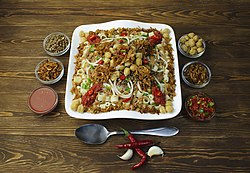


Koshary
| |
| Type | Mixed macaroni dish |
|---|---|
| Course | Main course |
| Place of origin | Egypt |
| Serving temperature | Warm or Hot |
| Main ingredients | Rice, lentils, macaroni, Vermicelli, tomato sauce, vegetable oil, onions, cumin, coriander |
| Variations | Chickpeas, Hot sauce, Garlic juice, Vinegar, Short spaghetti |
Koshary, kushariorkoshari (Egyptian Arabic: كشرى [ˈkoʃæɾi]) is Egypt's national dish and a widely popular street food.[1] It is a traditional Egyptian staple, mixing pasta, Egyptian fried rice, vermicelli and brown lentils,[2][3] and topped with chickpeas, a garlicky tomato sauce, garlic vinegar, and crispy fried onions. Sprinklings of garlic vinegar and hot sauce are optional.
In the Egyptian Books of Genesis,[4] the Ancient Egyptian term "Koshir" meant "Food of the rites of the Gods",[4] the Koshir was a breakfast dish that consisted of lentils, wheat, chickpeas, garlic and onions cooked together in clay pots.[4] It has been claimed that the original account of the book goes back to Manetho. However in the collected works of Manetho, no mention of Koshir could be found.[5] The word is not related to the Jewish dietary laws known as Kosher. A priest from Heliopolis described it as a food to eat after fasting on the 11th day of Pachons, a month in the ancient Egyptian calendar. Koshary is known as "The food of the Poor";[6] it consists of fried onions, lentils, rice, macaroni and a red sauce. It is somewhat related to Mediterranean cuisine, but the Egyptian dish has different ingredients and flavors, especially the local Egyptian lemon sauce, which gives it the unique taste for which the dish is popular.[7]
In 1853, in his book "Journey to Egypt and the Hijaz", explorer Richard Burton documented koshary as the breakfast meal of the people of Suez. It consisted of Egyptian lentils, rice, butter, onions and pickled lemons.[8]
Koshary was sold on food carts in its early years, and was introduced to restaurants later.[7]
This dish is widely popular among workers and laborers and the dish is well-suited to mass catering events such as conferences.[9] It may be prepared at home, and is also served at roadside stalls and restaurants all over Egypt; some restaurants specialize in koshary to the exclusion of other dishes, while others feature it as one item among many.[10] As traditionally prepared koshary does not contain any animal products, it can be considered vegan, as long as all frying uses vegetable oil.
Alexandrian koshary is quite different from other koshary recipes, with significant variations in taste and form. The cooking process includes yellow lentils and rice; it also uses curry and cumin in the rice, giving the koshary a uniform color. Also included are Egyptian rolled eggs, which are hard boiled and then fried in ghee or butter, as well as lightly pickled tomatoes instead of tomato sauce, and French fries on the side.[11] Another variation of the koshary dish in Egypt is Koshari Ads Asfar, which means koshary with yellow lentils.[12]
Koshary has also gained popularity outside of Egypt in recent years, especially in Eastern Arabia and Yemen. There are variations in each country or region, such as adding grilled vegetables and using basmati rice cooked either white or yellow. Other recipes of these regions include using other shapes of macaroni. The recipes could include chicken as well, making them closer to kabsa in some cases.[13]
The dish is served in Japanese carts and has some additions added on top of the original recipe. Nontraditional ingredients, which are not typically found in Egyptian recipes, are basil chicken, raw tomatoes, sour cream, fried eggs, Cheddar sauce, avocado slices, and spicy powder with jalapeño.[14]
An instant koshary akin to instant noodles in packaging and preparation, started appearing in Egypt as of 2020, which also needs hot water for 5—10 minutes to be ready to eat.[15]
Koshary: One of Egypt's most popular dishes is a carb-packed combination of macaroni, rice and beans flavored with tomatoes, onions, garlic and whatever else the chef feels like tossing in.
وإذا ما أشرقت الشمس تناول أهل السويس افطارهم الذي يتكون في فصل الصيف من فطيرة, أما في الشتاء فوجبة الإفطار أكثر أهمية وهي طبق من الكشري, عدس وأرز وسمن وبصل مقطع مسوى على نار هادئة أو ليمون مخلل.
|
| ||||||
|---|---|---|---|---|---|---|
| Beverages |
|
| ||||
| Breads |
| |||||
| Appetizers and salads |
| |||||
| Cheeses |
| |||||
| Soups |
| |||||
| Dishes |
| |||||
| Grilled meats |
| |||||
| Desserts |
| |||||
| Common ingredients |
| |||||
| Related cuisines |
| |||||
|
| |||||||||||||||||||||||||||||
|---|---|---|---|---|---|---|---|---|---|---|---|---|---|---|---|---|---|---|---|---|---|---|---|---|---|---|---|---|---|
| Regions |
| ||||||||||||||||||||||||||||
| Staples |
| ||||||||||||||||||||||||||||
| Shared |
| ||||||||||||||||||||||||||||
| Exemplars |
| ||||||||||||||||||||||||||||
| |||||||||||||||||||||||||||||
|
| |||||||||||||
|---|---|---|---|---|---|---|---|---|---|---|---|---|---|
| |||||||||||||
| North America |
| ||||||||||||
| South America |
| ||||||||||||
| Europe |
| ||||||||||||
| Africa |
| ||||||||||||
| West Asia |
| ||||||||||||
| Central Asia |
| ||||||||||||
| South Asia |
| ||||||||||||
| East Asia |
| ||||||||||||
| Southeast Asia |
| ||||||||||||
| Other |
| ||||||||||||
| |||||||||||||
|
| |
|---|---|
| National cuisines |
|
| Ethnic and regional cuisines |
|
| Lists |
|
| |